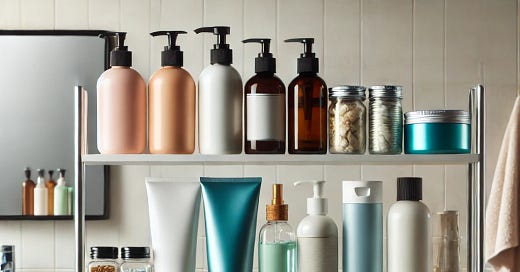Parabens
TLDR - Parabens are found in many personal care products and cause endocrine disruption.
Expanded
Parabens are a class of synthetic chemicals that act as preservatives. Common types include methylparaben, ethylparaben, propylparaben, and butylparaben. They are valued for their bactericidal and fungicidal properties, which help products stay fresh and safe to use over extended periods.
Where Are They Found?
Personal Care Products: Shampoos, conditioners, lotions, moisturizers, and deodorants often contain parabens to prevent microbial growth.
Cosmetics: Makeup products such as foundations, powders, lipsticks, and mascaras rely on parabens to extend their shelf life.
Pharmaceuticals: Some medications, including topical creams and ointments, use parabens as preservatives.
Food Items: Certain processed foods and beverages contain parabens to enhance their shelf life.
How They Impact the Human Body
Hormonal Disruption: Parabens can mimic estrogen by binding to estrogen receptors on cells. This can disrupt the normal function of the endocrine system, leading to hormonal imbalances. Such disruptions have been linked to reproductive issues, including decreased sperm count in men and early puberty in girls.
Breast Cancer Risk: Studies have detected parabens in breast tissue, raising concerns about their role in breast cancer development. Since parabens can act like estrogen, they may promote the growth of hormone receptor positive breast cancer cells.
Skin Irritation and Allergies: Parabens can cause allergic reactions and skin irritation, particularly in individuals with sensitive skin. This can manifest as redness, itching, and dermatitis.
Potential Developmental and Reproductive Toxicity: Some studies suggest that prenatal exposure to parabens may affect fetal development, potentially leading to adverse reproductive outcomes later in life.
Tips for Avoiding
Read Labels: Check the ingredient list on personal care products, cosmetics, and food items. Look for parabens, which are often listed as methylparaben, ethylparaben, propylparaben, and butylparaben.
The below apps can be great to scan barcodes and quickly find the safety rating of the project. Note that you will see discrepancies between the two apps. There are so many different artificial ingredients now that its difficult to track what is good and what is bad. In my opinion, anything artificial is bad.
Natural Products: Opt for natural and organic products that use alternative preservatives. Many brands now display parabenfree labels. I’d still highly recommend looking at the ingredients as branding can be misleading.
DIY Personal Care: Consider making your own personal care products at home using natural ingredients. There are plenty of recipes online for homemade shampoos, lotions, and deodorants.



